Sonoran Plant Profile: Star Solomon's Seal

Other Names: Starry Solomon’s Seal, pikvassáhiich (Karuk); This plant has gone by several names: Smilacina stellata, Vagnera stellata, Asteranthemum stellatum, Convallaria stellata (indicating its association with Lily of the Valley (Convallaria majalis) and its cardiotonic effects (although far milder)). “Smilacina” refers to it looking like Smilax, and “Maianthemum” presumably refers to a May Flower (another connection to Lily of the Valley).
Origin: Our species is native to North America. There are other related Maianthemum spp. in western Europe and eastern Asia.
Energetics: Warm & Moist. Vital Stimulant. Tonic. Relaxant. This plant is a rejuvenative at heart. It pumps the blood and moves the chi into areas which are lacking with a particular affinity for the lungs, gut, and joints while stimulating secretions. Wow!
Properties: Diuretic, demulcent, nutritive, anti-inflammatory, hypertensive, anodyne, rejuvenative, expectorant, circulatory stimulant, styptic, hemostatic
Uses: Injured joints, sprains, bruises, broken bones, arthritis, asthma, pleurisy, sore throat, cough, wounds, boils, dysbiosis, low Kidney chi, edema, colds, ease labor pains, constipation
Appearance & Habitat

This plant is a monocot with the customary parallel leaf veins and reproductive parts in 3s (some odd members of the genus are in 4s). There is a variability in growth dependent upon conditions. You’ll find this plant in an open meadow at higher elevations or strictly limited to almost full shade in our drier mountain ranges of the southwest. A closely related species, so-called False Solomon’s Seal, Maianthemum racemosum, generally has much wider leaves than M. stellatum. However, you can find Star Solomon’s Seal with leaves nearly as wide when the conditions are optimal. The main difference between these two species is in the flowers. The flowers of M. stellatum have conspicuous white tepals borne on simple racemes, whereas the flowers of M. racemosum have inconspicuous white tepals (very small) and are on paniculate racemes. All in all, M. racemosa looks to have a larger cluster of smaller flowers. The berries of each are red at maturity and favored by animals. Both flower clusters emerge from the growing tip (apex) quite differently from another well-known related medicinal, Solomon’s Seal (Polygonatum spp.) which has its flowers on the underside of the stem at the leaf nodes.
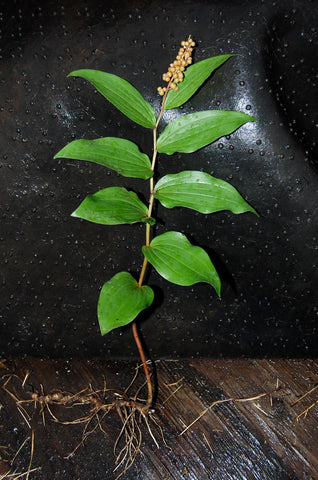
- Maianthemum racemosum - False Solomon's Seal
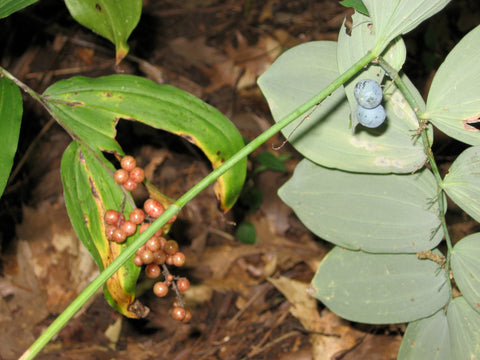
- Maianthemum racemosum & Polygonatum biflorum
These Maianthemum spp. are all commonly found in the richest, moistest areas of the southwest mountain ranges. Common plant associations might be Englemann Spruce, Oshá, Grape Root, Sweet Cicely, Valerian, Red Baneberry, Violet, Raspberry, or Big Tooth Maple. These are often perfect places to take a nap and contemplate your origins after a packed lunch in the forest. Then after nibbling a flower or two, and feeling your heart jump start a bit with increased air flow through the lungs you are once again ready to amble about the mountainside.
The sympodial rhizomes of M. stellatum interconnect over several feet to meters across the forest floor under favorable conditions. They can grow like a thick carpet of grass at high elevations which receive substantial snow fall. As they penetrate the soft, loamy soil they will occasionally branch off and shoot up a new aerial growth (apical meristem), then continue on across the subterranean habitat. This pattern seems more pronounced in my experience compared to False Solomon’s Seal which I’ve found growing as single, isolated rhizomes - sometimes over 25 years of age! The age being marked by the number of “seals” along the rhizome where each year’s leaf stem/flowering stalk emerged. I have not seen two come from one rhizome in a season. For this simple fact, I believe patches of M. stellatum more sustainable a harvest than M. racemosum. Others may disagree coming from a different region or ecological habitat. Several inches (4-8”) of growth can appear between leafing stems on M. stellatum rhizomes, whereas M. racemosum will often have only 1-2 cm between stem “seals.” That’s a significant difference. Granted, more study is to be done.
Generally speaking, these two plants can be used interchangeably for medicine.
Gathering and Medicine-making
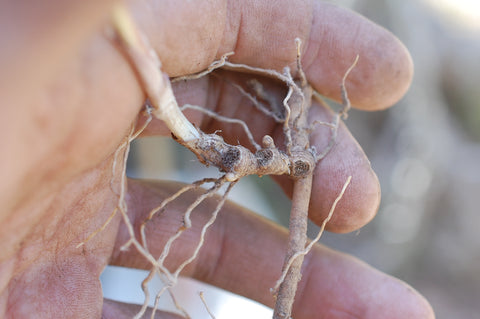
- Freshly harvested leafy stems with rhizomes attached - ready for re-planting
Get to know your environment. Acquainting yourself with your local plant community is the first step when looking to wildharvest. Star Solomon’s Seal, in particular, necessitates a degree of sensitivity to its habitat and growing conditions. There are certain ranges where stands are few and far between. These stands need special attention and care should be taken to monitor them over years’ time and steps taken to propagate them. Viewing any plant in this way will eventually help you to understand the habitat which is suited to this plant as well as help you to understand the true Nature of the plant. If a plant grows and is healthy, that indicates the conditions are suitable. There is a particular reason for that plant to be there. I have found that as we tune into these conditions, and their ebb and flow, it can inform us on the medicinal qualities of the plant; i.e. its true Nature.
It is true. A good deal of Star Solomon’s Seal’s habitat has been severely burned throughout the
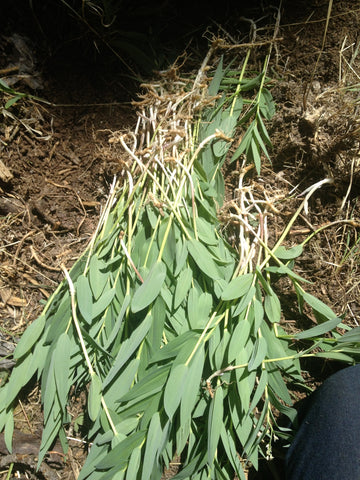
- Freshly harvested leafy stems with rhizomes attached
- ready for re-planting
southwest over the past several years. Sadly, this will take a long time for it to rehabilitate. But, fortunately, much of its terrain did not burn as severely due to a higher level of moisture in its habitat which repelled the flames to some degree. All this can be observed just by taking a hike through the mountains where it grows. I like to find a thick patch, a carpet of Star Solomon’s Seal. It reminds me of how Bermudagrass grows in the garden or near a wash. Its rhizomes penetrate an expanse of soil criss-crossing, overlapping and throwing up new shoots. This is the place to harvest, to tend to. I feel these ‘gardens” are meant to be tended. If we don’t, we may lose them. That’s my feeling. So I go in and clean them out a bit. Nipping some rhizome here as I pull up a length from the soil. I dig a bit to start then pull up the rhizomes, alongside with my fingers loosening the soil. They often will clump up like this between several downed trees where the soil is also quite rich and relatively loose as less heavy-weighted traffic passes through these areas, or just beneath the low-hanging skirt of a Spruce. As this plant grows so prolifically underground year-
by-year I can cull a significant amount from a patch while still leaving a substantial portion of the rhizomes intact. Additionally, I will cut back a dozen or so of the stems I’ve pulled up to re-plant. This is done with a segment of the rhizome still attached. And I leave any multi-sealed rhizomes to continue to grow (again, this is a big difference I’ve found between M. stellatum and M. racemosum). Once replanted, I give my final thanks and carry on back to camp to prepare a variety of medicines. I like it in several forms: fresh tincture, oil infusion, honey infusion or decoction, or dried rhizome for powdering. That leaves many options once back in the clinic or at home.

- Patch BEFORE re-planting
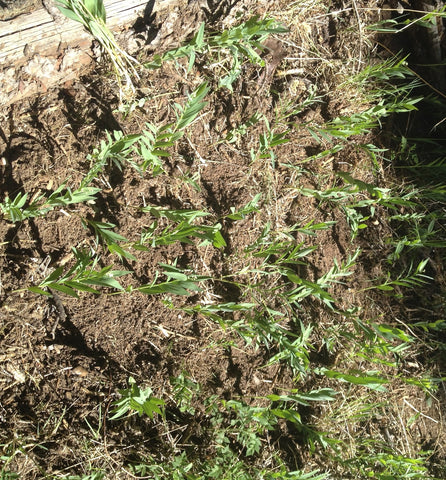
- Patch AFTER re-planting
The details of the preparations . . .
Fresh rhizome tincture: Chop rhizome to small pieces then combine with 2 parts full-strength alcohol by volume to 1 part weight of herb. (1:2, 95% alcohol)
Oil Infusion: Finely chop rhizome then add to glass jar. Cover with 5 parts organic extra virgin olive oil by volume to 1 part weight of herb. Keep this in a warm place for minimum 2-6 weeks. I like to place in a closed paper bag in the sun during the day. This will extract more quickly. Otherwise, on top of a water heater or even poured out into an electric roaster pan on the lowest heat setting, covered for several days (1:5).
Honey infusion: Same as the oil infusion but no heat is necessary, and you can leave for even longer - several months (1:5).
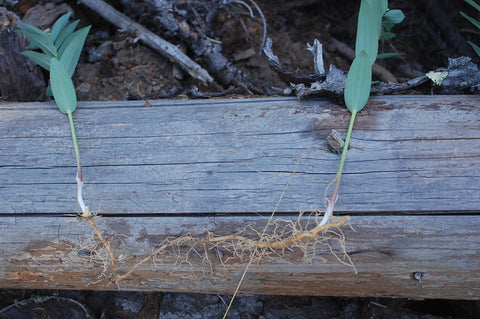
Honey Decoction: Bring the same ratio of herb to honey towards boiling in a glass, ceramic, or stainless steel pot. Once close to boiling remove from heat and allow to cool to ambient temperature. Then do it again. Once more. Then strain your honey out. Now you have both the honey decoction and candied root pieces. Same goes for the infusion method. You can try both and see which you prefer. I understand there’s an argument against heating honey as it is considered taboo in some traditions. However, this method has been used for making effective herbal preparations for several hundred years (if not much longer).
Powdered rhizome: Chop into small segments and let sit away from direct sunlight in a warm, dry place (near a wood stove in a cool, damp climate is great). Next take to grinding up the pieces until you have a fine powder. You may need to run it through a sieve after each grinding session. I consider this powder a nutritive supplement. There are more ways to apply it than I can write or come up with. You may even add it with other herbs (Ashwagandha, American Ginseng, . . . ) to make honey pastes. It’s a wonderful daily nutritive aid to strengthen joints after injury, enhance digestion and help build flesh, or stabilize an imbalance in fluid metabolism while exposed to hot, damp conditions. Adding it to capsules or simply stirring into tea or hot water also works. I use this primarily for myself as it can take a substantial amount of rhizome to provide a daily supply for several clients.

Running & Running
The image of a runner comes to mind . . .
Lungs strong, expanded, working at capacity to exchange bad air for clean. The heart is pumping a full volume of blood out to the extremities - all the sinews moistened, supple, elastic, and pumping. The mind is focused and alert. The whole body moves fluidly, in unison, while oxygen and blood pulse throughout the body.
These effects are common with the internal use of this plant. It has amazed me over and over again how quickly and effectively a few drops of the tincture can stimulate blood flow and bring relief to an injury or soften and loosen stiff, painful joints. I have found this to be true with the fresh rhizome tincture of M. racemosum as well.

I’ve observed a pattern emerge year after year in the summer rainy season in the southwest. It’s even more pronounced at higher elevations. A tendency towards fatigue, joint pain, tenderness or weakness (even increased injuries) potentially along with difficulty breathing, gasping for air, dizziness, and maybe even some palpitations. This kidney-lung-heart/cardiovascular connection is described in traditional systems of healing and there are physiological explanations I’m aware of that explain these changes. All the same, the pattern is clear. Why it exists in some and not others is an entirely different matter, but it does exist, and Maianthemum spp. do help. Being a close relative of Convallaria, or Lily of the Valley, Maianthemum spp. contain mild cardiac glycosides which stimulate the heart. This prompts an enhanced fluid exchange via the lungs and, in turn, the kidneys. Taken daily as a tonic during the warm, damp months of summer Maianthemum spp. act as a tonic to this axis (heart-lungs-kidneys) thereby improving breathing, systemic blood flow, and regulation of fluids in the body. I have combined it with Kola nuts, Pleurisy Root, and American Ginseng in tincture form to help one to adapt to extreme changes in barometric pressure (eg. going from high and dry to sea level or the tropics) or low blood pressure in general. The formula works really well for those who experience swelling around the ankles after being on a plane for a few hours. I’ve had some clients who develop asthma around the summer rainy season at high elevation. I suggest Star Solomon’s Seal along with Pleurisy Root, aka Butterfly Weed, as a daily tonic; taken as tincture, capsule, powder dissolved in hot water, or honey paste. As mentioned, I feel this helps move fluid from the lungs (no doubt with help from enhanced heart function).
Quickly, from a Chinese medicine perspective, if you stimulate the Heart it may have a beneficial effect on Liver function (as the Heart is Mother to the Liver) which governs ligaments and tendons. The suppleness of the joints returns by correcting a deeper deficiency with the herbal support.
Traditions
This plant has been used throughout the continent for likely thousands of years. The traditional uses have ranged from a food source (berries) to an eyewash for inflammation, or to improve digestion or “cleanse” the body. It seems to have a particular affinity for the female reproductive system as well as the skin and musculoskeletal system. The leaves of M. stellatum can be saved separately, and prepared as a tea. They (along with the berries) have been used to treat colds and rheumatism, traditionally. Traditional uses of the fresh stems and their “juice” in northern California include applying to fresh wounds to stop bleeding, directly to poison oak rash, and onto broken bones even with “the bones protruding through the skin.” The “peanut-shaped bulbs” (likely the mature rhizome) were placed in the mouth between the teeth and sucked on to relieve labor pains and help control postpartum hemorrhaging (Peters). Additionally, the leaves were made into a tea and drunk as a birth control by natives of the Nevada area (Vogel).
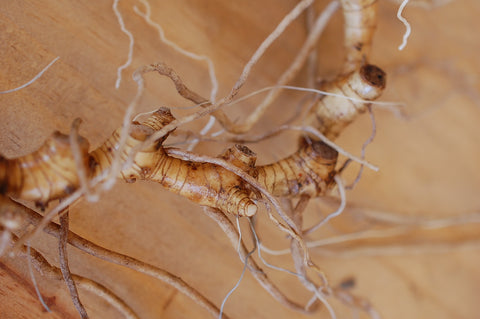
- Maianthemum racemosum - False Solomon's Seal
Matthew Wood mentions an herbalist (Brent Davis) who applies M. racemosum in cases of hormonal dysregulation in women and other liver-related conditions. This correlates with my experience of the plant and has an ethnobotanical context. Maianthemum spp. are quite different, in my opinion, than Polygonatum spp. even though there is a correlating function on joint tissue (tendons, ligaments). I feel the Maianthemum spp. are more broad and more pronounced in their functions.
No doubt the fresh roots contain saponins which is evidenced by their taste. The mashed roots were placed in streams by the Kawaiisu in order to stupefy fish for the catch.
References
http://en.wikipedia.org/wiki/Smilacina
http://herb.umd.umich.edu/herb/search.pl
Moore, Michael. 2003. Medicinal Plants of the Mountain West.
Peters, Josephine, and Ortiz Beverly. 2010. After the First Full Moon in April: A Sourcebook of Herbal Medicine from a California Indian Elder.
Vogel, Virgil J. 1970. American Indian Medicine.
Wood, Matthew. 2009. The Earthwise Herbal: A Complete Guide to New World Medicinal Plants.
You can find out more about John's Class Offerings and Consultation services at www.johnjslattery.com







Nicely written.Thank you for sharing.
] Oebora zym.qnqj.desertortoisebotanicals.com.gbs.jc http://slkjfdf.net/
] Uzezvo yvp.xnvg.desertortoisebotanicals.com.voa.fb http://slkjfdf.net/
] Agevono sgm.bikj.desertortoisebotanicals.com.iaw.ru http://slkjfdf.net/
] Oodivexam zpj.uzzj.desertortoisebotanicals.com.wvg.jl http://slkjfdf.net/
Leave a comment